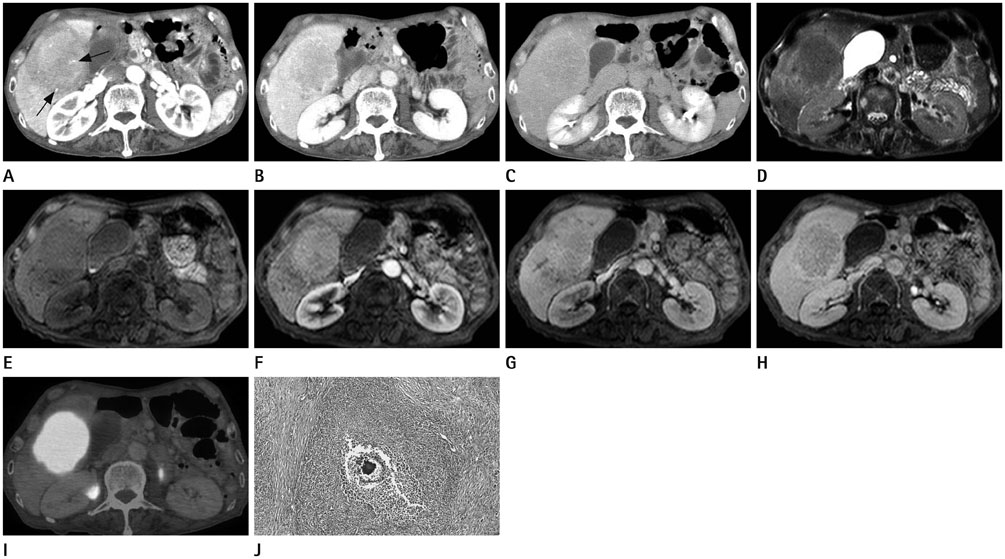J Korean Soc Radiol.
2015 May;72(5):352-357. 10.3348/jksr.2015.72.5.352.
Hepatic Actinomycosis Mimicking a Malignant Tumor: Three Case Reports
- Affiliations
-
- 1Department of Radiology, Yeungnam University College of Medicine, Daegu, Korea. sungho1999@ynu.ac.kr
- KMID: 1793893
- DOI: http://doi.org/10.3348/jksr.2015.72.5.352
Abstract
- Various forms of hepatic actinomycosis can be observed on the imaging studies. We report here the imaging findings of three cases of hepatic actinomycosis, which presented as a solid mass mimicking a malignant tumor. With respect to their enhancement pattern on the contrast-enhanced CT and MR images, one case showed homogeneous and persistent enhancement throughout three phases, while the other two cases showed variable degrees of delayed enhancement with their own features during the portal and equilibrium phases, suggesting that they have abundant fibrosis at different stages. Also, normal vascular structures traversing the masses were noted in all three cases. One core needle biopsy and two surgical resections were performed, and the masses were pathologically proven to be hepatic actinomycosis. In conclusion, we need to be aware that a hepatic tumor with abundant fibrosis, in which the normal vasculature is traversing, can be diagnosed as hepatic actinomycosis.
Figure
Reference
-
1. Shah HR, Williamson MR, Boyd CM, Balachandran S, Angtuaco TL, McConnell JR. CT findings in abdominal actinomycosis. J Comput Assist Tomogr. 1987; 11:466–469.2. Kim HS, Park NH, Park KA, Kang SB. A case of pelvic actinomycosis with hepatic actinomycotic pseudotumor. Gynecol Obstet Invest. 2007; 64:95–99.3. Kasano Y, Tanimura H, Yamaue H, Hayashido M, Umano Y. Hepatic actinomycosis infiltrating the diaphragm and right lung. Am J Gastroenterol. 1996; 91:2418–2420.4. Lai AT, Lam CM, Ng KK, Yeung C, Ho WL, Poon LT, et al. Hepatic actinomycosis presenting as a liver tumour: case report and literature review. Asian J Surg. 2004; 27:345–347.5. Sharma M, Briski LE, Khatib R. Hepatic actinomycosis: an overview of salient features and outcome of therapy. Scand J Infect Dis. 2002; 34:386–391.6. Miyamoto MI, Fang FC. Pyogenic liver abscess involving Actinomyces: case report and review. Clin Infect Dis. 1993; 16:303–309.7. Ha HK, Lee HJ, Kim H, Ro HJ, Park YH, Cha SJ, et al. Abdominal actinomycosis: CT findings in 10 patients. AJR Am J Roentgenol. 1993; 161:791–794.8. Hochsztein JG, Koenigsberg M, Green DA. US case of the day. Actinomycotic pelvic abscess secondary to an IUD with involvement of the bladder, sigmoid colon, left ureter, liver, and upper abdominal wall. Radiographics. 1996; 16:713–716.9. Ko SW, Jung YY, Kang HK. MR findings of hepatic actinomycosis: case report. J Korean Radiol Soc. 2003; 48:327–330.10. Isozaki T, Numata K, Kiba T, Hara K, Morimoto M, Sakaguchi T, et al. Differential diagnosis of hepatic tumors by using contrast enhancement patterns at US. Radiology. 2003; 229:798–805.
- Full Text Links
- Actions
-
Cited
- CITED
-
- Close
- Share
- Similar articles
-
- MR Findings of Hepatic Actinomycosis: Case Report
- Unique Imaging Features in Hepatic Actinomycosis Accompanied by an IgG4-Related Inflammatory Pseudotumor: A Case Report
- Primary Hepatic Actinomycosis Mimicking Hepatic Malignancy with Metastatic Lymph Nodes by F-18 FDG PET/CT
- A case of primary hepatic actinomycosis
- Abdominopelvic Actinomycosis Mimicking Peritoneal Carcinomatosis: A Case Report




